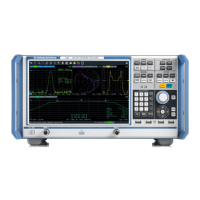Concepts and Features
R&S
®
ZNB/ZNBT
218User Manual 1173.9163.02 ─ 53
Independent source powers for Port 1 and Gen1 can be configured in addition, if so
desired.
Arbitrary Power Configuration
Arbitrary power configuration is also part of option R&S ZNB/ZNBT-K4.
Internal Second Source
If an internal second source is available, the mixer measurements outlined above (and
many other measurements) can be performed without an additional external generator;
see Chapter 5.7.8, "Internal Second Source", on page 227. However, be aware of the
limited source connectivity (described there).
5.7.4.1 Calibration Options
In arbitrary mode, the R&S ZNB/ZNBT automatically calibrates the source and receive
frequency ranges of all ports, according to the frequency conversion settings in the
"Port Settings" dialog or in dedicated configuration dialogs.
●
SMARTerCal is the recommended calibration method for frequency conversion
measurements.
●
For measurements on non-linear DUTs, an additional scalar power calibration is
recommended; for details refer to Chapter 5.5.7, "SMARTerCal", on page 180.
●
A load match correction (optional) involves an additional reverse sweep. It can pro-
vide a significant improvement of the transmission S-parameter measurements if
the load ports are poorly matched.
Select the appropriate correction type according to your accuracy and speed require-
ments. Notice that none of the correction types provide the phase information for trans-
mission S-parameters.
5.7.4.2 Scalar Mixer Measurements
Scalar Mixer measurements are included in option R&S ZNB/ZNBT-K4.
RF mixers convert an RF signal at one frequency into a signal at another frequency.
The frequency that is to be shifted is applied at the RF input. The frequency shifting
signal (from a local oscillator, LO) is applied to the RF mixer's LO port, resulting in an
output signal at the mixer's Intermediate Frequency (IF) port. For a given RF signal, an
ideal mixer would produce only two IF outputs: one at the frequency sum of the RF and
LO (IF = RF + LO), and another at the frequency difference between the RF and LO (IF
= |RF – LO|). Filtering can be used to select one of these IF outputs and reject the
unwanted one.
Optional Extensions and Accessories

